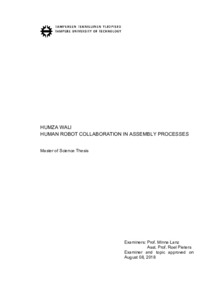Human Robot Collaboration in Assembly Processes
Wali, Humza (2018)
Wali, Humza
2018
Automation Engineering
Teknisten tieteiden tiedekunta - Faculty of Engineering Sciences
This publication is copyrighted. You may download, display and print it for Your own personal use. Commercial use is prohibited.
Hyväksymispäivämäärä
2018-12-05
Julkaisun pysyvä osoite on
https://urn.fi/URN:NBN:fi:tty-201811262766
https://urn.fi/URN:NBN:fi:tty-201811262766
Tiivistelmä
Human robot collaboration (HRC) in assembly processes, is a concept which aims to integrate the human workforce with the robots in a shared workspace. This is carried out to complement the human workforce to achieve key manufacturing metrics e.g. efficiency, ergonomics, etc. Assembly of the switch module (DIN rail components’ assembly) was taken to be the product under investigation. Design of human robot collaborative assembly process was explored while considering the following objectives and knowledge areas: Design for Assembly (DFA) methodology, rules for task assignment between the human worker and the robot, Identification and mitigation of process hazards, and trainable collaborative setups. A total of five DFA axioms were found to be relevant for the design of human robot collaborative assembly process. Task Assignments between the human and the robot was explored while considering the following objectives: Optimal assembly cycle times and workspace ergonomics. Three out of four phases of assembly process offered room for collaborative endeavors. The task assignments during these assembly phases ensured optimal cycle times and work space ergonomics. Risk assessment along with risk mitigation strategies were evaluated on the basis of ISO 12100. Hand guided frame teaching methodology was used to train the collaborative setup. This enabled an operator friendly/oriented approach towards the design and implementation of collaborative assembly tasks. The obtained results ensured a reliable and industry scalable implementation of human robot collaborative assembly process.
